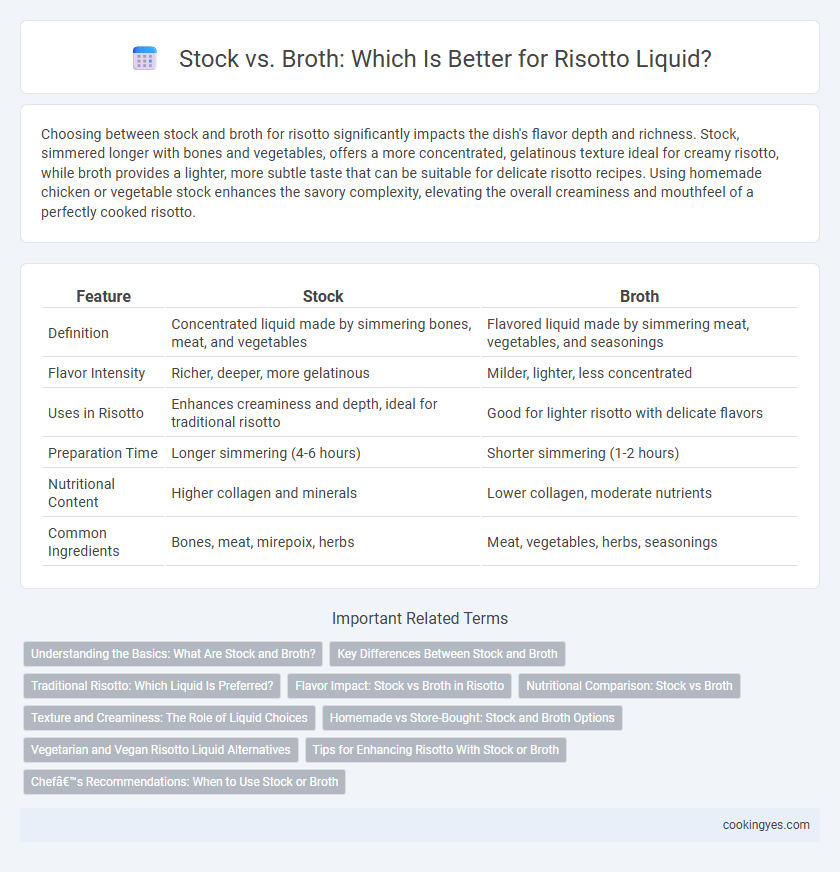Choosing between stock and broth for risotto significantly impacts the dish's flavor depth and richness. Stock, simmered longer with bones and vegetables, offers a more concentrated, gelatinous texture ideal for creamy risotto, while broth provides a lighter, more subtle taste that can be suitable for delicate risotto recipes. Using homemade chicken or vegetable stock enhances the savory complexity, elevating the overall creaminess and mouthfeel of a perfectly cooked risotto.
Table of Comparison
| Feature | Stock | Broth |
|---|---|---|
| Definition | Concentrated liquid made by simmering bones, meat, and vegetables | Flavored liquid made by simmering meat, vegetables, and seasonings |
| Flavor Intensity | Richer, deeper, more gelatinous | Milder, lighter, less concentrated |
| Uses in Risotto | Enhances creaminess and depth, ideal for traditional risotto | Good for lighter risotto with delicate flavors |
| Preparation Time | Longer simmering (4-6 hours) | Shorter simmering (1-2 hours) |
| Nutritional Content | Higher collagen and minerals | Lower collagen, moderate nutrients |
| Common Ingredients | Bones, meat, mirepoix, herbs | Meat, vegetables, herbs, seasonings |
Understanding the Basics: What Are Stock and Broth?
Stock is a flavorful liquid made by simmering bones, vegetables, and aromatics for several hours, rich in gelatin and providing a silky texture ideal for risotto. Broth is made by cooking meat, vegetables, and seasonings, resulting in a lighter, more robust flavor. Choosing stock over broth enhances risotto's creamy consistency and depth of taste essential for authentic Italian recipes.
Key Differences Between Stock and Broth
Stock, made primarily from simmering bones and aromatics, provides a richer, gelatinous texture for risotto, enhancing its creamy consistency and depth of flavor. Broth, prepared by cooking meat, vegetables, and seasonings, offers a lighter, more seasoning-forward liquid that can impart a clearer taste but less body. Choosing stock over broth for risotto typically results in a more robust and velvety dish due to higher collagen content extracted from bones during stock preparation.
Traditional Risotto: Which Liquid Is Preferred?
Traditional risotto recipes typically use stock, such as chicken, vegetable, or fish stock, as the preferred liquid for cooking because it provides a rich, savory flavor that enhances the creaminess of the dish. Broth, which is usually lighter and less concentrated than stock, may result in a less intense taste profile, making stock the favored choice among chefs and traditional cooks. Using homemade or high-quality stock ensures a deeper umami complexity essential to authentic risotto.
Flavor Impact: Stock vs Broth in Risotto
Using stock rather than broth in risotto imparts a richer, more complex flavor due to its longer simmering process with bones and vegetables, which extracts deeper umami notes. Broth, typically lighter and clearer, provides a more subtle base that allows the main ingredients like Arborio rice and Parmesan cheese to shine without overpowering the dish. For optimal flavor impact, homemade chicken or vegetable stock with concentrated aromas enhances the creamy texture and depth that define a perfect risotto.
Nutritional Comparison: Stock vs Broth
Stock used in risotto typically contains more concentrated nutrients such as collagen, minerals, and gelatin extracted from bones, enhancing its nutritional profile. Broth, made primarily from meat and vegetables, tends to have a lighter flavor and lower protein content compared to stock. Choosing stock over broth for risotto increases intake of minerals like calcium and magnesium, contributing to a more nutrient-rich dish.
Texture and Creaminess: The Role of Liquid Choices
Using stock instead of broth in risotto enhances texture and creaminess due to its higher gelatin content extracted from simmered bones, which creates a richer mouthfeel. Broth, typically lighter and less concentrated, results in a thinner consistency and less velvety finish. Choosing a high-quality chicken or vegetable stock optimizes absorption and contributes to the signature luxurious texture of authentic risotto.
Homemade vs Store-Bought: Stock and Broth Options
Homemade stock offers richer, more complex flavors and a natural depth that enhances the creamy texture of risotto, while store-bought broth often contains additives and a saltier profile that can overpower delicate ingredients. Using homemade stock made from simmering bones, vegetables, and herbs allows precise control over seasoning and intensity, providing a balanced foundation for the rice to absorb. Store-bought broths, although convenient, may require dilution or additional seasoning adjustments to mimic the nuanced taste achieved with slow-cooked, fully homemade stock.
Vegetarian and Vegan Risotto Liquid Alternatives
Vegetarian and vegan risotto recipes benefit from using vegetable stock or broth as the primary liquid, providing rich flavor without animal products. Homemade vegetable stock made from onions, carrots, celery, and mushrooms enhances umami and depth, while store-bought options should be low in sodium and free from additives. For added complexity, miso broth or seaweed-infused water can serve as excellent vegan risotto liquid alternatives, boosting taste and nutrition.
Tips for Enhancing Risotto With Stock or Broth
Using homemade chicken or vegetable stock rich in natural flavors enhances risotto's depth and complexity. For a lighter taste, low-sodium broth allows greater control over seasoning while maintaining moisture for the rice. Gradually ladling warm stock or broth ensures even absorption and creates a creamy, perfectly textured risotto.
Chef’s Recommendations: When to Use Stock or Broth
Chefs recommend using stock in risotto for a richer, more complex flavor due to its long simmering with bones and vegetables, ideal for authentic Italian recipes. Broth offers a lighter, clearer taste, making it suitable for delicate risottos or when quick preparation is needed. For the best results, homemade chicken or vegetable stock enhances depth, while store-bought broth works well for convenience without overpowering other ingredients.
Stock vs broth for risotto liquid Infographic

 cookingyes.com
cookingyes.com